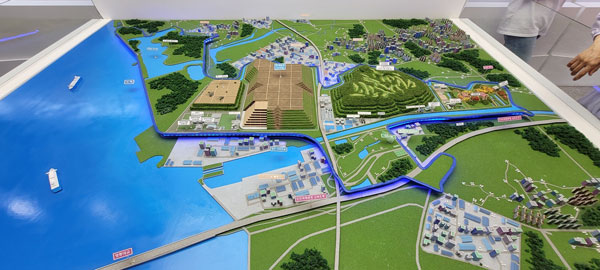Incheon citizens' voices of dissatisfaction amplify over metropolitan landfill site

[3D Model of Sudokwon Landfill Site Management Corporation. Photo credit: Olivia Kim]
Incheon residents have strongly opposed the continuation of landfill sites in the capital region beyond 2025, despite the significant challenges involved.
They are citing concerns over the environmental public health impact of the landfills.
These landfill sites, covering an area equivalent to 2,300 soccer fields, are responsible for waste disposal and energy production for Seoul, Gyeonggi Province, and Incheon.
The landfill sites in the capital region serve as necessary waste management facilities, where waste from 64 out of the 66 city and county districts, excluding Yeoncheon in Gyeonggi Province and Ongjin County in Incheon, are processed.
Originally planned for completion in 2016, the landfill sites have continued to operate despite ongoing concerns.
However, the amount of waste received per day has decreased from 12,000 tons in 2021 to 7,200 tons in 2023.
This reduction is attributed to the current policy of only accepting residual waste after intermediate construction waste treatment.
Starting January 2026, only incinerated residue will be permitted for landfill disposal.
Once direct landfilling is prohibited, the remaining incinerated residue will be allowed for disposal at designated resource recovery facilities.
There are three landfill sites in total each divided into zones for efficient waste management.
For instance, the second landfill site is divided into 24 zones, each measuring 300 meters in width and length.
This zoning approach helps minimize the impact of odor emitted by the waste.
While construction and general waste were previously mixed and landfilled until the second site, separate landfilling has been implemented since the creation of the third site.
Research has indicated that when sulfates in construction waste come into contact with moisture, they can generate unpleasant odors.
However, as construction waste has decreased, the significance of separate landfilling has diminished.
The landfill sites also currently manage various types of wastewater, including leachate from the landfill, food waste wastewater, and wastewater from the resource circulation energy town.
A patented temperature and humidity control system facilitates the growth of microorganisms that are used in the treatment process.
Approximately 90% of the wastewater is purified using these microorganisms, with chemical agents employed for further purification.
Adjacent to the landfill gas management facility, a greenhouse facility further utilizes biogas and provides employment opportunities for Incheon residents.
Despite the slight odor and the shadows caused by its proximity to the landfill, the greenhouse cultivates plants that are sold as souvenirs.
As the debate intensifies over the continued operation of the landfills, it seems Incheon residents will continue to advocate for terminating landfill sites in the capital region by 2025, emphasizing the importance of sustainable waste management practices for the environment and the community's well-being.

- Olivia Kim / Grade 11
- The Stony Brook School

![THE HERALD STUDENT REPORTERS [US]](/assets/images/logo_student_us.png)
![THE HERALD STUDENT REPORTERS [Canada]](/assets/images/logo_student_ca.png)
